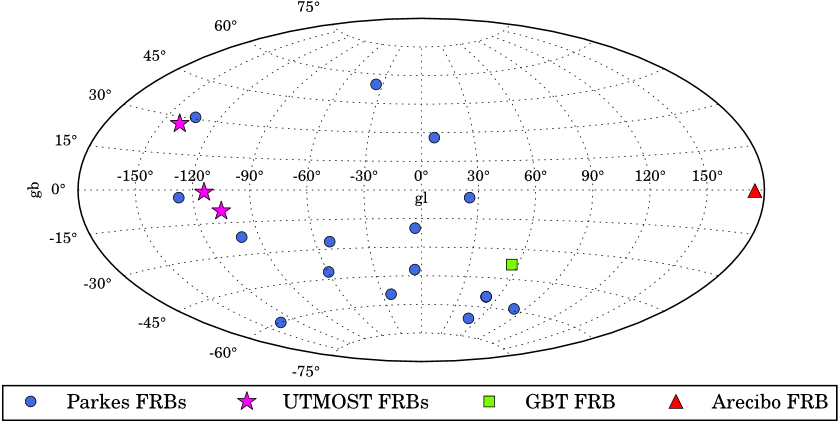




Did you find this useful? Give us your feedback














[...]
339 citations
...Searches for FRBs at the Parkes telescope and with the UTMOST telescope in Australia have primarily been done with the heimdall18 pipeline, which uses brute force dedispersion techniques on GPUs (Champion et al. 2016; Caleb et al. 2017)....
[...]
...Searches for FRBs at the Parkes telescope and with the UTMOST telescope in Australia have primarily been done with the heimdall pipeline, which uses brute force dedispersion techniques on GPUs (Champion et al., 2016; Caleb et al., 2017)....
[...]
320 citations
...There is also evidence that the FRB rate at low frequencies ν < 700 MHz is lower than at 1.4 GHz (Karastergiou et al. 2015; Rowlinson et al. 2016; Burke-Spolaor et al. 2016; Caleb et al. 2017; Chawla et al. 2017; Sokolowski et al. 2018)....
[...]
245 citations
[...]
225 citations
212 citations
...◦8 (see Caleb et al. 2017 for the details of this observing mode)....
[...]
...…(Lorimer et al. 2007; Keane et al. 2012; Thornton et al. 2013; Burke-Spolaor & Bannister 2014; Spitler et al. 2014; Masui et al. 2015; Petroff et al. 2015a, 2017; Ravi, Shannon & Jameson 2015; Champion et al. 2016; Keane et al. 2016; Ravi et al. 2016; Caleb et al. 2017; Bannister et al. 2017)....
[...]
2,415 citations
...Based on this, we measure a detectable event rate of (R), R (F 11 Jy ms) 0.78+1.24−0.57 × 102 events sky−1 d−1 (4) at the 95 per cent confidence level (Gehrels 1986), above a full power boresight fluence of 11 Jy ms as parametrized by equation (2), at the half-power FoV....
[...]
1,644 citations
...The pulses are typically of durations of a few milliseconds, and exhibit a dispersion sweep characteristic of propagation through a cold diffuse plasma E-mail: manishacaleb@gmail.com (Lorimer et al. 2007; Thornton et al. 2013)....
[...]
...For instance, ≈80 h of follow up for the Lorimer burst (Lorimer et al. 2007), ≈80 h for FRB 131104 (Ravi, Shannon & Jameson 2015) and ≈110 h of selected FRB positions (Petroff et al. 2015) at the Parkes radio telescope yielded no repeats....
[...]
1,137 citations
1,093 citations
...The pulses are typically of durations of a few milliseconds, and exhibit a dispersion sweep characteristic of propagation through a cold diffuse plasma E-mail: manishacaleb@gmail.com (Lorimer et al. 2007; Thornton et al. 2013)....
[...]
883 citations
...However, one FRB is now known to repeat in a non-periodic manner (FRB 121102; Spitler et al. 2016), opening up possibilities for other progenitor models....
[...]
...We note that the repeat FRB pulses from the Arecibo FRB 121102 exhibit a wide range of spectral indices (γ ∼ −10 to +14; Spitler et al. 2016), similar to giant pulses from the Crab pulsar....
[...]
The telescope’s field of view, sensitivity and high duty cycle make it a near ideal survey instrument for finding FRBs and other radio transients.
The authors find that on average ∼86 per cent of the total S/N is concentrated in the upper half of the band (∼836–850) as the antennas are tuned to maximum sensitivity at 843 MHz.
The authors expect CHIME to detect ∼70 events beam−1 d−1 for Tsys = 50 K, S/N =10, G = 1.38 K Jy−1, Np = 2 and FoV = 250 deg2 (Connor et al. 2016a; Ng et al. 2017).
Since late 2015, the authors have been using UTMOST to search for fast radio transients for an average of 18 h a day, while simultaneously timing more than 300 pulsars weekly (Bailes et al., in preparation, Jankowski et al., in preparation).
4. The primary advantage of the array is that a pulse from a far-field point source is detected in a maximum of three adjacent FBs at any given time, confirmed by extensive pulsar observations.
The telescope can access the southern sky for δ < +18◦, and for most parts of the sky the authors tend to observe reasonably close to the meridian, in order to maximize sensitivity.
Based on the time spent on sky and the number of detections made, the authors measure a rate of 0.017+0.03−0.01 events beam−1 d−1 at UTMOST, for the sensitivity achieved during the upgrade.
Their fluence limit of the survey, that is the fluence of the narrowest detectable pulse Flim can be parametrized as Flim ≈ 11 ( Wms)1/2 Jy ms (2)where, 11 Jy is the UTMOST flux limit for S/N = 10, G = 3.0 K Jy−1, ν = 16 MHz, W = 1 ms, Np = 1 and Tsys = 400 K.
The false positive rate at UTMOST is high due to RFI caused by mobile phone handsets, which produce narrow band (5-MHz) emission in their band, typically in ≈20 ms pulses.
The authors quantify this tension by calculating the probability of observing three or more events to be 14.3 per cent, assuming Poisson statistics with a mean of 1.3.
The process followed is:(i) obtain 352 data streams (8-bits/sample), one for each FB, at 655.36-µs sampling;(ii) search time series for single pulses with width, 0.655 36 < W < 41.943 ms (W = 2N × 0.655 36 ms, where N = 0,1,2,...) and DMs in the range 100 < DM < 2000 pc cm−3;(iii) remove events occurring simultaneously in more than three FBs at a given instant in time;(iv) classify only events with S/N ≥10, DM ≥100 pc cm−3 and W ≤ 41.943 ms as potential FRB candidates.
The authors havenow implemented a fine channel mode (320 channels) that will potentially increase their sensitivity and the FRB detection rate by a factor of √